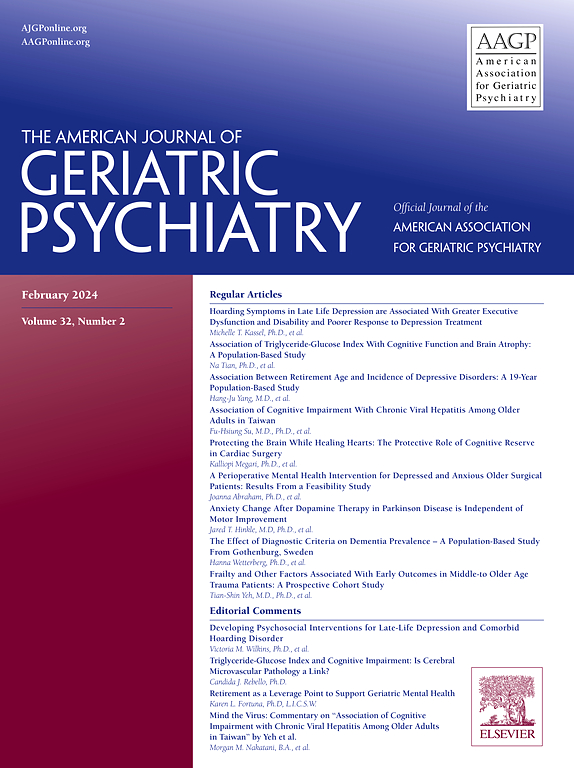17. 圣徒治疗难治性抑郁症:现实世界的发现
IF 3.8
2区 医学
Q1 GERIATRICS & GERONTOLOGY
引用次数: 0
摘要
在接受药物治疗的重度抑郁症老年人中,据估计至少有三分之一的人对至少两种适当的抗抑郁药物试验没有反应。FDA目前在考虑新疗法的适应症时使用的是难治性抑郁症的定义。尽管电痉挛疗法(ECT)是一种非常有效的干预重度抑郁症或伴有精神病性特征的抑郁症的方法,但由于担心其不良副作用,包括顺行性和逆行性遗忘,以及心血管或神经系统合并症患者的风险增加,因此在老年人中的应用可能受到限制。重复经颅磁刺激(rTMS),特别是间歇性脑波爆发刺激(iTBS),已经成为治疗抑郁症的一种有前途的非侵入性替代方法。新的斯坦福加速智能神经调节疗法(SAINT)方案最近获得了FDA的批准,包括每天10次针对左背外侧前额叶皮层(DLPFC)的高剂量iTBS,这使得治疗时间缩短到5天,而不是传统rTMS典型的4到6周疗程。该方案还利用功能连接(fcMRI)引导的个性化算法靶向左DLPFC区域,该区域被确定为与亚属前扣带皮层最不相关。在最初的临床试验中,SAINT方案显示出令人印象深刻的结果,超过80%的患者在开放标签试验中达到缓解,在随机假对照试验的四周随访期间,50-80%的患者在某个时间点达到缓解标准。然而,评估SAINT在老年人群中的疗效的研究仍然缺失。此外,在临床试验之外,需要对现实世界的患者群体进行治疗,以更好地衡量这种治疗的有效性。方法阿肯色大学医学科学学院(UAMS)通过其介入精神病学项目,是美国第一个在临床环境中为患者提供SAINT的机构。我们收到了来自美国各地以及当地的病人转诊,其中大多数是自我转诊。在全面的精神病学评估后,如果患者符合治疗难治性重度抑郁症的标准,没有精神病特征,并且没有MRI或手术的禁忌症,则给予SAINT TMS。在UAMS精神科脑研究所对每位患者进行静息状态功能磁共振成像。然后将fMRI数据上传到Magnus Medical,为每位患者在左侧DLPFC内制定个性化的治疗目标。每例患者每天10次,连续5天。每组持续10分钟,每组之间至少休息50分钟。患者每天接受18000次脉冲,在治疗系列结束时总共接受90000次脉冲。所有处理均在MagVenture MagPro X100系统(MagVenture a /S,丹麦)上进行,该系统配备了MagVenture Cool-B65 a /P线圈组,可在90%电机阈值的刺激强度下提供iTBS 1800脉冲模式。刺激强度也进行了校正,以解释治疗的皮质深度的个体差异。结果共10例患者(平均年龄 = 64岁,范围:33 ~ 79岁;6名女性,4名男性)在撰写本文时已在UAMS完成了SAINT治疗方案。在迄今为止接受治疗的10名患者中,有8名患者年龄在60岁或以上(平均年龄 = 71岁),这构成了我们的老年成人队列。使用Maudsley分期法,所有患者均符合至少“中度”难治性抑郁症的标准(即平均得分 = 10,量表范围3-15)。平均而言,患者服用五到七种抗抑郁药物失败,十分之八的隆胸策略失败,两种电痉挛疗法失败。在我们的老年队列中,MOCA平均得分为26.7。用PHQ-9和GDS-15测量抑郁症状的严重程度和对治疗的反应。在老年人队列中,平均基线GDS-15为11,平均基线PHQ-9为14.5。第5 d末,平均GDS为6.63,平均PHQ-9为9.63。使用GDS,共有4名患者符合缓解或缓解的标准。使用PHQ-9,共有2例患者在治疗第5天达到缓解标准,另外1例患者在2周后的随访中达到缓解标准。没有严重的副作用报告,最常见的副作用是疲劳和轻度至中度头痛。结论:在包括明显治疗耐药的老年人的患者群体中,SAINT方案似乎至少为这些患者中的一部分提供了希望。 需要进一步的工作来进一步确定SAINT的纳入和排除标准,确定可能有复发风险的患者,并制定维持或再治疗方案。到目前为止,SAINT仅由传统的医疗保险覆盖,或者患者必须自掏腰包。SAINT在治疗时间短、副作用负担相对较低和有效性方面的益处表明,这种治疗应该更广泛地适用于难治性抑郁症的老年人。本文章由计算机程序翻译,如有差异,请以英文原文为准。
17. SAINT FOR TREATMENT-RESISTANT DEPRESSION: REAL WORLD FINDINGS
Introduction
Among older adults with major depressive disorder who receive pharmacologic treatment, it has been estimated that at least one-third do not respond to at least two adequate trials of antidepressants—i.e., the definition of treatment-resistant depression currently used by the FDA when considering indications for new therapies. Although electroconvulsive therapy (ECT) is a highly effective intervention for severe depression or depression with psychotic features, its use in older adults can be limited due to concerns for adverse side effects, including anterograde and retrograde amnesia, and increased risks in individuals with cardiovascular or neurologic comorbidities.
Repetitive transcranial magnetic stimulation (rTMS), particularly in the form of intermittent theta-burst stimulation (iTBS), has emerged as a promising non-invasive alternative for treatment of depression. The novel Stanford Accelerated Intelligent Neuromodulation Therapy (SAINT) protocol, which recently received FDA clearance, consists of ten daily high-dose sessions of iTBS targeting the left dorsolateral prefrontal cortex (DLPFC), which enables treatment time to be condensed into five days, rather than the typical four to six week course of conventional rTMS. The protocol also utilizes functional connectivity (fcMRI)-guided, personalized, algorithmic targeting of the region of the left DLPFC that is identified as being the most anticorrelated with the subgenual anterior cingulate cortex.
In the initial clinical trials, the SAINT protocol demonstrated impressive results, with over 80% of patients achieving remission in the open-label trial, and 50-80% meeting remission criteria at some point during the four week follow-up period in the randomized sham-controlled trial. However, studies evaluating the efficacy of SAINT in the geriatric population remain absent. Furthermore, real-world patient populations need to be treated to better gauge the effectiveness of this treatment outside of clinical trials.
Methods
The University of Arkansas for Medical Sciences (UAMS), through its Interventional Psychiatry Program, was the first site in the United States to offer SAINT to patients in a clinical setting. We received patient referrals from all over the United States, as well as, locally, with the majority being self-referrals. After a comprehensive psychiatric evaluation, patients were offered SAINT TMS if they met criteria for treatment resistant MDD without psychotic features and had no contraindications for the MRI or procedure. A resting-state fMRI was obtained for each patient in the Brain Research Institute housed within the psychiatry department at UAMS. The fMRI data was then uploaded to Magnus Medical to develop a personalized treatment target within the left DLPFC for each patient.
Each patient received ten sessions a day for 5 consecutive days. Each session lasted 10min and there was a minimum of 50min rest between sessions. Patients received 18,000 pulses per day and a total of 90,000 by the end of the treatment series. All treatments were delivered on a MagVenture MagPro X100 system (MagVenture A/S, Denmark) equipped with a MagVenture Cool-B65 A/P coil set to deliver iTBS 1800 pulse pattern at stimulation strength of 90% motor threshold. The stimulation strength was also corrected to account for individual differences in cortical depth of the treatment.
Results
A total of 10 patients (mean age = 64 years, range: 33 to 79; 6 female, 4 male) have completed the SAINT treatment protocol at UAMS at the time of this writing. Of the 10 patients treated to date, 8 were 60 years or older (mean age = 71 years) which made up our older adult cohort. Using the Maudsley Staging method, all patients met criteria for at least “moderate” treatment resistant depression (i.e., mean score = 10, scale range 3-15). On average, patients had failed between five to seven antidepressant medications, eight of ten had failed augmentation strategies, and two had failed ECT. The mean MOCA score was 26.7 for our older adult cohort. Severity of depressive symptoms and response to treatment was measured with both the PHQ-9 and the GDS-15. Among the older adult cohort, the mean baseline GDS-15 was 11 and the mean baseline PHQ-9 was 14.5. At the end of day 5, the mean GDS was 6.63, and the mean PHQ-9 was 9.63. Using the GDS, a total of four patients met criteria for either response or remission. Using the PHQ-9, a total of 2 patients met criteria for remission by treatment day 5, and 1 additional patient went on to meet criteria for remission on follow up 2 weeks later. No serious adverse effects were reported, with the most commonly reported side effects of the procedure being fatigue and mild to moderate headache.
Conclusions
Even in a patient population that included significantly treatment-resistant older adults, the SAINT protocol appears to offer promise for at least a portion of these patients. Further work is needed to further define inclusion and exclusion criteria for SAINT, to identify patients who may be at risk of relapse, and to develop maintenance or re-treatment protocols. To date, SAINT is covered only by traditional Medicare, or patients must pay out-of-pocket. The benefits of SAINT in terms of short duration of treatment, relatively low side effect burden, and effectiveness suggest that this treatment should be more broadly accessible to older adults with treatment-resistant depression.
求助全文
通过发布文献求助,成功后即可免费获取论文全文。
去求助
来源期刊
CiteScore
13.00
自引率
4.20%
发文量
381
审稿时长
26 days
期刊介绍:
The American Journal of Geriatric Psychiatry is the leading source of information in the rapidly evolving field of geriatric psychiatry. This esteemed journal features peer-reviewed articles covering topics such as the diagnosis and classification of psychiatric disorders in older adults, epidemiological and biological correlates of mental health in the elderly, and psychopharmacology and other somatic treatments. Published twelve times a year, the journal serves as an authoritative resource for professionals in the field.

 求助内容:
求助内容: 应助结果提醒方式:
应助结果提醒方式:


